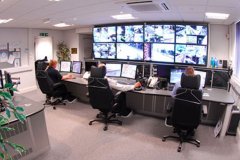Répressive et préventive
Estimative
Monitoring techniques such as CCTV, graffiti paint detectors and sensors, drones, surveys...etc. has been increasing throughout the whole decade, both in public spaces and transportation networks.
In transportation networks, CCTV and other traditional security measures (private security guards and patrolling security staff) are used in combination and in multiple spaces including trains, wagons and facilities (tunnels, stations or tracks for instance). CCTV serves multiple purposes. First of all, it monitors potentially hazardous situations. Secondly, through CCTV, police officers can identify and follow suspects. Moreover, it provides powerful evidence in court. Last but not least, the use of CCTV might be useful to boost public confidence and act as a deterrent, according to the interviews. CCTV can be equipped with facial recognition software.
Graffiti paint detectors and graffiti sensors are tools to detect the graffiti vandals and afterwards report their actions in order to stop them. In the UK, the Graffiti E‐nose (a tool designed in Sydney, Australia) detects the paint up to a distance of 45 metres and is able to distinguish between spray paint and solvent. The system has sensors that detect the chemical in the air and also register images in real time. The information about the chemical components is sent to a computer where it is identified and quantified.
A discrete way to pick up and to film people spraying graffiti is from the air with a noiseless drone. Deutsche Bahn, Europe's largest railway and rail infrastructure operator, began in 2013 using drones to stop graffiti being painted on trains.
In terms of evaluation, surveys are a suitable tool to monitor and analyse graffiti's impact. We find two versions of this tool in the UK. Firstly, the National Travel Survey (NTS) is "the primary source of data on personal travel patterns in Great Britan. The NTS is an established household survey, which has been running continuously since 1988. It is designed to monitor long-term needs in personal travel and to inform the develepment of policy" (as the website of the UK Government states). The survey analyses, among other aspects, the factors affecting travel, such as graffiti. However, the question of graffiti is not at the heart of this tool, since graffiti incidents appear indirectly in the survey and do not constitute a specific section of the questionnaire.

